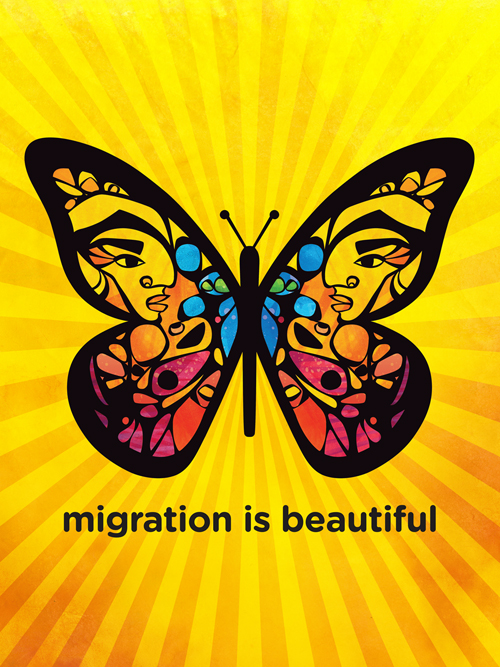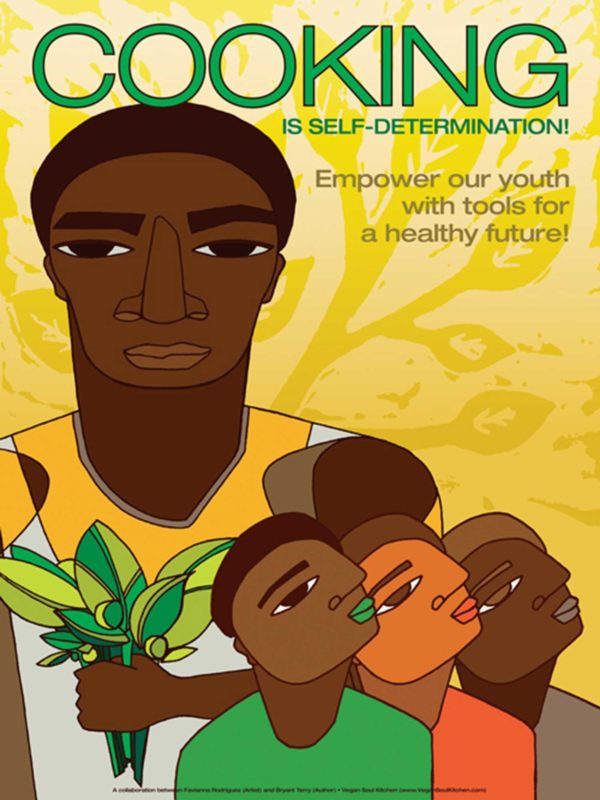One of the most frequent questions I get when I lecture in universities around the country is: “What Art School did you go to?”
I actually did not attend art school, in fact I didn’t finish college. I left the University of California Berkeley after 3 years of study because I did not find that a college education was truly fulfilling me. I didn’t know how to explain it then, but I believe that at age 20, I was in search of creating something that incorporated my many identities, something that I could really feel passionate about.
In 1996, I had just recently left home at age 17 to go to college. Three years later, my new found freedom, my new radical brown friends at UC Berkeley, and my embracing of activism helped me make the decision that school was not what I wanted at that moment. I wanted to be an artist and an entrepreneur. Shortly before I turned 20, I decided to take a big risk, leave school, and make a big leap to do two things: make art and start a small business. But this leap of faith was something that even surprised me. I don’t know how I arrived to this decision, because 3 years earlier I was graduating high school with honors, points in Advanced Placement tests, with the intent of going to CAL to pursue a lucrative career, either in medicine or engineering or architecture.
My parents, who migrated to the United States precisely so that I could attend college and have better opportunities than they had, were extremely disappointed with me and thought I was crazy to say that I wanted to be an artist. More than 10 years later, they are now my biggest art fans, but it took years of arguing for them to accept it.
Art did not offer the kind of job security they wanted for their children. So Art was not a part of my formal education. Although I would have loved to take art classes as a high school student, it was not something that was deemed acceptable in my parent’s eyes. In fact, even up until the age of 16, I thought I was going to be a gynecologist. I knew, in my heart, that I LOVED to be an artist, but it was never something I imagined as a career.
One thing my parents DID do was enroll me in after school art programs with Chicano artists who offered free art classes in our neighborhood – the Fruitvale district in Oakland, CA. I learned from illustrators and muralists, including Xochilt Nevel Guerrero, who is responsible for some of the most beautiful murals in Oakland. But my art practice was viewed as a hobby and not as a potential career.
When I finally left school at age 20, I faced a dilemma. Although I was a talented young artist, I had never formally developed an art portfolio that could grant me admission to any art school. I had not even taken art in high school. Plus, I had spent one year (from Grade 11-12) applying to scholarships to attend UC Berkeley, applying for Financial Aid, etc. Going to Art School was not just somethign I could do, because I had not prepared for this route in high school.
I was in a situation that many young talented people of color find themselves in, which was, that I was a promising young artist with no ability to attend art school.
I deliberated and deliberated, and one day I heard some words from a mentor of mine that would shape my practice. And that was, that everyone is a lifelong student, and that we have the ability to learn not just in classrooms, but from informal education spaces – to learn from workshops, from community classes, from peer spaces, and cultural centers. It was so simple, yet so applicable to the crisis I was undergoing.
When I heard this, I made the commitment to myself that I would seek out teachers, I would find the people who I wanted to learn from, and I would create my own art education, develop my own curriculum, and essentially, seek out my Master Teachers. That is what I did. I started meeting mentors, asking them for support, for guidance and for lessons. I absorbed like a sponge, and I slowly built the visual vocabulary that defines me as an artist. I learned how to make a screenprint, how to design on a computer, how to make an etching, how to write a business plan – and I learned from professional artists and often, my own peers.
And its’a practice I take seriously and am strongly committed to. Last week, I spent six days at a place called Anderson Ranch, located in Aspen, Colorado. I was there to take a class with the great Mexican artist, Enrique Chagoya. I would spend full days in the studio during class, and then my evenings making art, practicing the new techniques I learned. I could not believe how happy, secure, and fulfilled I felt. It was a strong realization that makign art, in a space alongside teachers and students, is something that helps me thrive. In this environment, I found, I could be my best self.
Here are a few tips for other artists around the practice of being a lifelong student in the arts:
1. Take art classes in field that interest you, and treat them as labs – places where you can experiment, open yourself up to new techniques, and learn from others. I let go of the idea that I will produce finished pieces, and instead, go crazy trying everythign out. I also time myself so that I don’t get attached to what I make.
2. High quality art classes are often in the range of $300-$800, so I set aside a budget every year to take workshops at least once a quarter. You can start small, and set aside the price of going out to eat, it’s not food for the stomach but food for your heart. Even if you don’t take a class, you can use the funds to pay for the time of a master teacher, or studio rental for 1 day. Of course, there are free classes too, but I am not going to focus on those in this blog.
3. I recently realized how important it was for me to leave my home to take a class. If possible, you should leave and go to a place where you can treat it like a vacation. Take time off work to do your class.
4. Sign up for e-newsletters of places that offer classes so that you are in the loop around special offers. Often, the best classes fill up fast, so its important to stay updated on things in your area or your field of interest.
5. Read books. I hardly learn from books, but recently, I started reading about Chinese woodblock printing in preparation for a woodblock class I’m taking next week. I realized how incredibly valuable it is to prepare for workshops by reading up on the material. In fact some people can learn entirely from books.
6. Reach out to your masters now! If you know of someone you admire, reach out to them, ask them to mentor you in a particular area. Maybe you need help with color theory, or maybe with learning how to cut a linoblock. I recently reached out to one of my masters to ask him to help me hand print on Japanese paper. Whatever you do, do it now. I say this because, masters are not around for ever. One of my favorite teachers of all time, Carlos Cortez, passed away a few years back, and I often wished I had spent more time with him.
7. Thank your masters. I always try to give my masters pieces of my work and to express my gratitude to them, because their lessons are real gifts to me.
8. Cross the sea to find your master. I have a dream of going to Japan to connect with masters of the Mokuhanga tradition, which is a Japanese style of printmaking. So every year, I apply to a fund that facilitates exchanges between Japanese and American artists. I’ve applied at least 5 times now, and have not gotten it. But I don’t give up, because it is my dream to learn this craft.
9. Be committed to your “schooling.” This is definitely what I’ve had the hardest time with. Usually, a few days before my scheduled class, I will realize I have to much work to do, so I sometimes consider cancelling my class. But thankfully, my mom reminds me to view this as an investment in myself, and to make sure to treat my learning as sacred time.
10. Investigate scholarships or fee waivers for your classes. Many of these art programs offer scholarships. Also, many cities around the country have funding for artists who want to take workshops (usually around $500). Investigate.
11. List your classes in your resume.
Here are the places I take classes at and/or that I recommend for workshops:
Anderson Ranch, Colorado: by far my BEST art workshop EVER!
Kala Art Institute, Berkeley, CA: LOVE this place! I always take monotype classes and digital printing classes.
SF Center for the Book, San Francisco, CA: Letterpress classes rock
Donkey Mill Art Center, Hawaii: If you can go to a beautiful environment and make art, why not!?
Robert Blackburn Studios, New York, NY: Awesome space!
Photos in this blog are from the monotype class I took last week at Anderson Ranch, with master teacher, Enrique Chagoya.
Follow me on Twitter!





love your blog..keep up the good work and most of all enjoy the journey…I am a mature age undergrad Arts student and having a ball, only wish I had of made time to do this Arts degree when I was a lot younger.
i love what you wrote faviana, wish i had seen this 15years ago lol 🙂